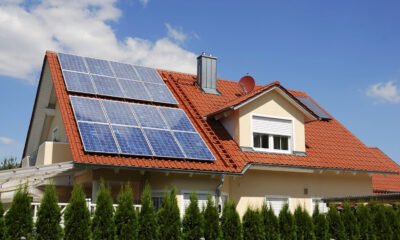

Features
Sustainable building means more attractive and comfortable homes
As a child, come the evening when everyone was back from their respective jobs, schools and social engagements, my father would lock the door of our house and ‘shut the world out’ – a saying that has stayed with me and as a result, those I have lived with, ever since.
However by locking the door, neither we nor our homes cease to interact with the society and the environment inhabited. Around 27% of the carbon emissions in the UK come from our homes, according to the Centre for Sustainable Emissions.
Whilst there are actions we can take to reduce this, which will no doubt be the subject of another column (such as turn down the heating, not run the tap whilst brushing teeth etc) there is a growing realisation that larger, more structural change is needed. For a home to care for those living within it, it doesn’t have to be taking from the world around it.
This is where the concept of sustainable housing comes in. Housing development has direct and indirect impacts on the environment. Through its design, construction, and operation, housing represents a significant level of consumption of natural materials, water, and energy.
Green or sustainable development is that which allows people to build structures that fulfil their purpose whilst minimising the impact upon the environment, in all the above ways, for both current users and future generations.
Whilst the UK government has set a target for all new build housing to be zero-carbon by 2016, it is not clear whether this means that the building is zero-carbon until the point of its construction, or for life. This is the only true indication that a building is sustainable – that it continues to be efficient and enables the environment in which it is in to thrive.
Ultimately, a home is there to look after its inhabitants, and so the most truly environmentally sustainable houses are those that allow the owner to live in a warm and healthy place without having a devastating environmental impact.
No matter how sustainable a building may have been in its design and construction, it can only remain so if it is operated responsibly and maintained properly. Currently, £23 billion is spent annually on home renovation, maintenance and repair.
Sustainable housing is more fuel efficient. Around 4.5 million people in the UK live in fuel poverty (latest figures from Department for Energy & Climate Change) – the largest number in Europe. If homes did not need so much energy to operate, this would not be a problem.
New developments are being built that not only use fewer resources in their construction, but consider how the property can be maintained in a more energy efficient way. Southerly facing windows let in more light – both aesthetically pleasing and reducing the need to switch on electric lights. Insulated walls are warming and reduce heating bills, as well as preventing the need for a huge metal radiator.
In an effort to reduce energy usage, designers look to cut out air leakage and may smartly position windows and walls and place awnings to offer shade during the summer while maximising solar gain in the winter. All of these things demonstrate that for a home to be environmentally friendly, it does not have to be uncomfortable and unappealing.
There are also some more systemised structures that can help to reduce energy usage. Solar power has become a more ingrained and acceptable form of environmental efficiency, via panels and heating, and waste-water may be minimised by utilising water conserving fixtures such as ultra-low flush toilets and low-flow shower heads. ‘Grey water’ such as that from the washing machine can be used to flush said toilets.
Starting at environmental impact from this level is a smart choice, as it appears to infringe less. People don’t have to make the decision to live sustainably; they just do.
Sustainable building development must therefore reduce energy consumption for both the transportation and building costs, as well as the living costs, enabling people to efficiently use energy, water and other resources in their day to day life. The common objective is that building should reduce the overall impact of the built environment on human health and the natural environment.
The most criticised issue about constructing environmentally friendly buildings is the price. Solar panels don’t come cheap, and modern technologies tend to cost more money.
However studies have shown that most green buildings cost a premium of less than 2%, but yield 10 times as much over the entire life of the building. As usual, it is an offset between knowledge of upfront cost and the unknown lifecycle cost. A study in the US has shown that over a 20-year life period, some green buildings have yielded $53 to $71 per square foot back on investment.
Environmentally sound and economically viable? Now you’re talking.
Francesca Baker is curious about life and enjoys writing about it. A freelance journalist, event organiser, and minor marketing whizz, she has plenty of ideas, and likes to share them. She writes about music, literature, life, travel, art, London, and other general musings, and organises events that contain at least one of the above. You can find out more at www.andsoshethinks.co.uk.
Further reading:
‘What was an ecohouse is now just a really well-designed house’
Campaigners say government planning policy will ‘wreck countryside’
Study paints UK as a leader in green building


 Environment10 months ago
Environment10 months agoAre Polymer Banknotes: an Eco-Friendly Trend or a Groundswell?

 Environment12 months ago
Environment12 months agoEco-Friendly Home Improvements: Top 7 Upgrades for 2025

 Features9 months ago
Features9 months agoEco-Friendly Cryptocurrencies: Sustainable Investment Choices

 Features10 months ago
Features10 months agoEco-Friendly Crypto Traders Must Find the Right Exchange




























